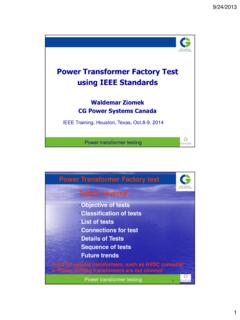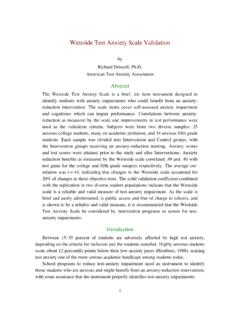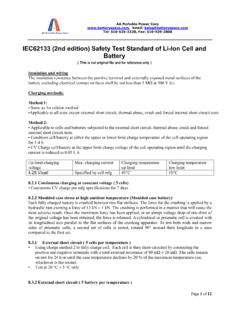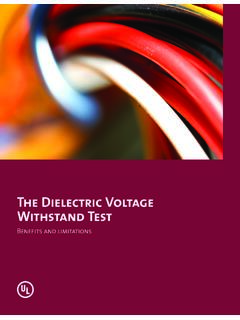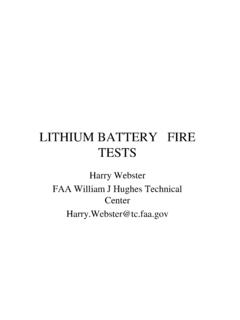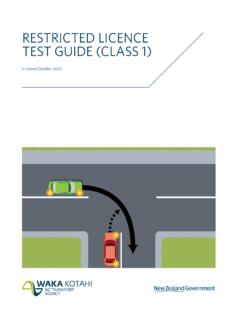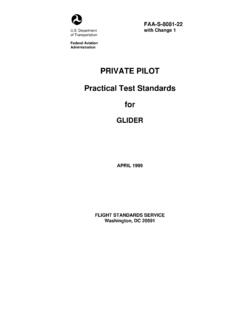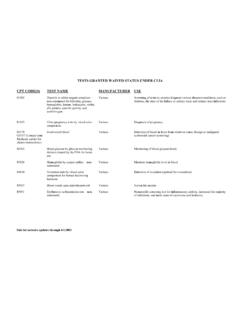Transcription of Lithium Battery UN38.3 Test Report
1 Lithium Battery Test Report Report No.: TCT140425009B3-1 Page 1 Hotline: 400-6611-140 Tel: 86-755- 27673339 Fax: 86-755-27673332 Lithium Battery Test Report Prepared For : Shenzhen Guojunengyuan Co., Ltd. F6, Building 5, Jintai Industrial Zone, Tanluoxincun, Dalang, Longhua Town, Bao'an District, Shenzhen Samples Name: Polymer Lithium ion Battery Model : GJ602030 Shenzhen TCT Testing Technology Co., Ltd. Prepared By : 1F, Building 1, Yibaolai Industrial Park, Qiaotou Village, Fuyong Town, Baoan District, Shenzhen, Guangdong Report No.: TCT140425009B3-1 Issued Date: May 27, 2016 Conclusion: Shown in the results of test Report Note: This Report shall not be reproduced except in full, without the written approval of Shenzhen TCT Testing Technology Co.
2 , Ltd. This document may be altered or revised by Shenzhen TCT Testing Technology Co., Ltd. personnel only, and shall be noted in the revision section of the document. The test results in the Report only apply to the tested sample. Tested by: Inspected by: Approved by: Approval Date: 2016. 05. 27 Lithium Battery Test Report Report No.: TCT140425009B3-1 Page 2 of 15 Hotline: 400-6611-140 Tel: 86-755- 27673339 Fax: 86-755-27673332 I SAMPLE DESCRIPTION Product Name Polymer Lithium ion Battery Battery Type GJ602030 Manufacturer Shenzhen Guojunengyuan Co., Ltd. Address F6, Building 5, Jintai Industrial Zone, Tanluoxincun, Dalang, Longhua Town, Bao'an District, Shenzhen Trade Mark ---- Shape Prismatic Size (L W T) ( )mmNominal Voltage Rated Capacity 300mAh Limited Charge Voltage Charge Current 60mA Maximum Continuous Charge Current 300mA End Charge Current 3mA Cut-off Voltage Standard Discharge Current 60mA Maximum Discharge Current 300mA Cell Number 1 PCS Cell Model GJ602030 Date of Receipt Apr.
3 25, 2016 Date of Test May 27, 2016 II STANDARD Recommendations on the Transport of Dangerous Goods, Manual of Test and Criteria (ST/ Section ) III TEST ITEM 1. Altitude simulation 2. Thermal test 3. Vibration 4. Shock 5. External short circuit 6. Impact / Crush 7. Overcharge 8. Forced discharge IV TEST METHOD tests to shall be conducted in sequence on the same cell or Battery . tests and shall be conducted using not otherwise tested cells or batteries. Test may be conducted using undamaged batteries previously used in tests to for purposes of testing on cycled batteries. Batteries of 1#~14# are full charged after one cycle; Batteries of 15#~18# are full charged after fifty cycles; Component cells of 19#~23# are 50% charged after one cycle; Lithium Battery Test Report Report No.: TCT140425009B3-1 Page 3 of 15 Hotline: 400-6611-140 Tel: 86-755- 27673339 Fax: 86-755-27673332 Component cells of 24#~33# are full discharged after one cycle; Component cells of 34#~43# are full discharged after fifty cycle; In order to quantify the mass loss, the following procedure is provided: Mass loss (%) = (M1-M2)/M1 x 100 where M1 is the mass before the test and M2 is the mass after the test.
4 When mass loss does not exceed the values in Table below, it shall be considered as "no mass loss". Mass M of cell or Battery Mass loss limit M 1g 1g M 75g M 75g Leakage means the visible escape of electrolyte or other material from a cell or Battery or the loss of material (except Battery casing, handling devices or labels) from a cell or Battery such that the loss of mass exceeds the values in Table above. In test 1 to 4, cells and batteries meet this requirement if there is no leakage, no venting, no disassembly, no rupture and no fire and if the open circuit voltage of each test cell or Battery after testing is not less than 90% of its voltage immediately prior to this procedure.
5 The requirement relating to voltage is not applicable to test cells and batteries at fully discharged states. 1. Altitude simulation Test cells and batteries shall be stored at a pressure of kPa or less for at least six hours at ambient temperature (20 5 C). 2. Thermal test Test cells and batteries are to be stored for at least six hours at a test temperature equal to72 2 C, followed by storage for at least six hours at a test temperature equal to - 40 2 C. The maximum time interval between test temperature extremes is 30 minutes. This procedure is to be repeated until 10 total cycles are complete, after which all test cells and batteries are to be stored for 24 hours at ambient temperature (20 5 C). For large cells and batteries the duration of exposure to the test temperature extremes should be at least 12 hours. 3. Vibration Cells and batteries are firmly secured to the platform of the vibration machine without distorting the cells in such a manner as to faithfully transmit the vibration.
6 The vibration shall be a sinusoidal waveform with a logarithmic sweep between 7 Hz and 200 Hz and back to 7 Hz traversed in 15 minutes. This cycle shall be repeated 12 times for a total of 3 hours for each of three mutually perpendicular mounting positions of the cell. One of the directions of vibration must be perpendicular to the terminal face. The logarithmic frequency sweep shall differ for cells and batteries with a gross mass of not more than 12 kg (cells and small batteries), and for batteries with a gross mass of more than 12 kg (large batteries). For cells and small batteries: from 7 Hz a peak acceleration of 1 gn is maintained until 18 Hz is reached. The amplitude is then maintained at mm (1 6 mm total excursion) and the frequency increased until a peak acceleration of 8 gn occurs (approximately 50 Hz). A peak acceleration of 8 gn is then maintained until the frequency is increased to 200 Hz.
7 For large batteries: from 7 Hz to a peak acceleration of 1 gn is maintained until 18 Hz is reached. The amplitude is then maintained at mm ( mm total excursion) and the frequency increased until a peak acceleration of 2 gn occurs (approximately 25 Hz). A peak acceleration of 2 gn is then maintained until the frequency is increased to 200 Hz. Lithium Battery Test Report Report No.: TCT140425009B3-1 Page 4 of 15 Hotline: 400-6611-140 Tel: 86-755- 27673339 Fax: 86-755-27673332 4. Shock Test cells and batteries shall be secured to the testing machine by means of a rigid mount which will support all mounting surfaces of each test Battery . Each cell or Battery shall be subjected to a halfsine shock of peak acceleration of 150 gn and pulse duration of 6 milliseconds.
8 Each cell or Battery shall be subjected to three shocks in the positive direction followed by three shocks in the negative direction of three mutually perpendicular mounting positions of the cell or Battery for a total of 18 shocks. However, large cells and large batteries shall be subjected to a half-sine shock of peak acceleration of 50 gn and pulse duration of 11 milliseconds. Each cell or Battery is subjected to three shocks in the positive direction followed by three shocks in the negative direction of each of three mutually perpendicular mounting positions of the cell for a total of 18 shocks. 5. External short circuit The cell or Battery to be tested shall be temperature stabilized so that its external case temperature reaches 55 2 C and then the cell or Battery shall be subjected to a short circuit condition with a total external resistance of less than ohm at 55 2 C.
9 This short circuit condition is continued for at least one hour after the cell or Battery external case temperature has returned to 55 2 C. Cells and batteries meet this requirement if their external temperature does not exceed 170 C and there is no disassembly, no rupture and no fire during the test and within six hours after the test. 6. Impact / Crush Test procedure Impact (applicable to cylindrical cells not less than mm in diameter) The sample cell or component cell is to be placed on a flat smooth surface. A mm diameter, at least 6 cm long, or the longest dimension of the cell, whichever is greater, Type 316 stainless steel bar is to be placed across the centre of the sample. A kg kg mass is to be dropped from a height of 61 cm at the intersection of the bar and sample in a controlled manner using a near frictionless, vertical sliding track or channel with minimal drag on the falling mass.
10 The vertical track or channel used to guide the falling mass shall be oriented 90 degrees from the horizontal supporting surface. The test sample is to be impacted with its longitudinal axis parallel to the flat surface and perpendicular to the longitudinal axis of the mm diameter curved surface lying across the centre of the test sample. Each sample is to be subjected to only a single impact. Test Procedure Crush (applicable to prismatic, pouch, coin/button cells and cylindrical cells less than mm in diameter) A cell or component cell is to be crushed between two flat surfaces. The crushing is to be gradual with a speed of approximately cm/s at the first point of contact. The crushing is to be continued until the first of the three options below is reached. (a) The applied force reaches 13 kN kN; (b) The voltage of the cell drops by at least 100 mV; or (c) The cell is deformed by 50% or more of its original thickness.
